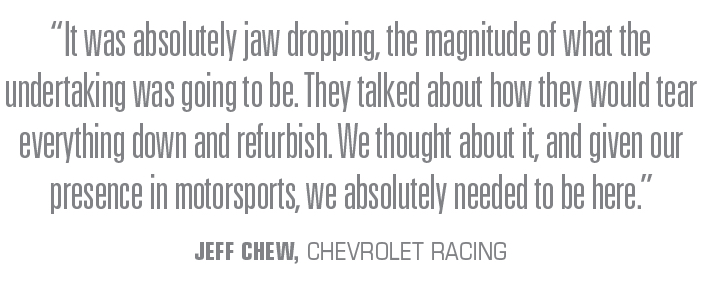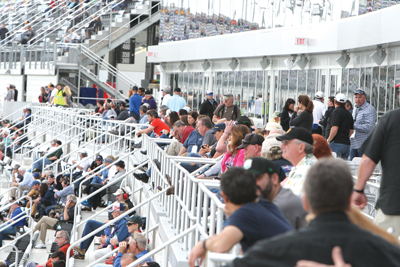At first, the sign vendor couldn’t grasp the concept. Daytona International Speedway’s new marquee had to match the scale of its grandstand, which stretches nine-tenths of a mile long. The vendor, Jones Sign of Green Bay, thought the project would fall in line with its other stadium work, such as Lambeau Field.
Not so, Daytona officials said. They were developing the first “motorsports stadium,” tackling something unprecedented in NASCAR’s 68-year history. The speedway’s dimensions dwarf the typical NFL facility, and the marquee had to equal the task for taking the auto racing experience to a higher level.
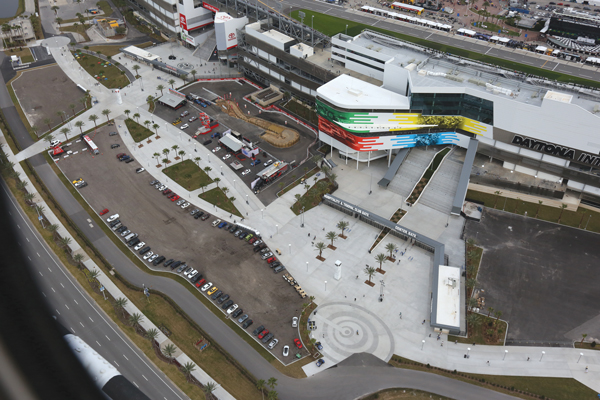 |
The project provides amenities on par with major league arenas and stadiums.
Photo by: ISC |
“When you’re talking about a stadium that stretches that far, I want people to be able to see it from a distance,” said track President Joie Chitwood. “We wanted a marquee to represent the ‘World Center of Racing.’ That was a big deal for us. If you’re on the east coast of Florida, you will see the sign.”
Big has been the name of the game since the day that the three-year, $400 million makeover for Daytona was first announced. Dubbed Daytona Rising, the project has transformed the 57-year-old facility and represents the most ambitious effort by a racetrack to provide amenities on par with major league arenas and stadiums.
As the final touches are put on construction and officials with International Speedway Corp., the track’s owner, look back on the development, the sign company wasn’t the only entity that had difficulty understanding the scope of Daytona’s aggressive plan.
Chitwood recalls visiting potential founding partners and media outlets to lay out the vision. He got a lot of blank stares and responses of “Whaaat?” after sharing images for reshaping the facility and introducing modern amenities, while getting rid of the corporate hospitality clutter outside the track.
“It was tough to grasp,” Chitwood acknowledged.
Over time, though, Daytona’s stakeholders — and the sign company — came to understand the vision.
The end result was a massive, 350-foot-long sign attached to the building’s exterior. The sign can glow in multiple colors, providing an impressive visual for motorists driving past the track on International Speedway Boulevard.
The sign’s predominant color was green during the recent Rolex 24 race, which drew a crowd of 35,000 to get a first peek at the improvements.
The project goes before the masses this week as crowds arrive in the buildup to Sunday’s Daytona 500.
Sponsors buy in
It all began more than three years ago as speedway officials started showing the initial blueprints for Daytona Rising. The theme: bigger and bolder across the board for the gate entrances, concourses and vast sponsorship zones.
“We met with Joie and the ISC team at Homestead at the final race of the season in 2012,” said Jeff Chew, Chevrolet Racing’s manager of strategic planning and operations. “He laid out this plan for the rebirth of Daytona. It was absolutely jaw dropping, the magnitude of what the undertaking was going to be. They talked about how they would tear everything down and refurbish. We thought about it, and given our presence in motorsports, we absolutely needed to be here. We feel like we’re part of the fabric of the sport and we’d be conspicuous by our absence, quite honestly.”
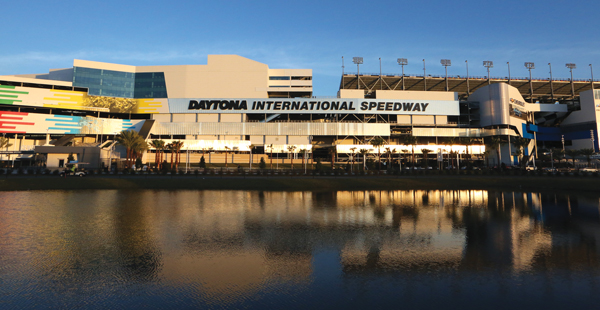 |
The approach to Daytona leaves no doubt about the scope of the project.
Photo by: ISC |
The same was true for Toyota, a relative newcomer to NASCAR, having joined the premier Sprint Cup Series in 2007. Compared with Chevrolet and others that have been part of the sport for decades, Toyota still fights the perception as an outsider whose vehicles are all produced in Japan. In fact, more than 70 percent of Toyota cars sold in the U.S. are built here as well, according to Keith Dahl, Toyota’s corporate manager of motorsports and engagement marketing. To hammer that point home for the speedway’s 1 million annual visitors, Toyota stepped to the front of the line to become the track’s first founding partner in February 2014.
Toyota would later be joined by Chevrolet, Florida Hospital and Sunoco. As founding partners, each company gets to brand one of the massive new entrances, dubbed “injectors.” They are spending millions over the next 10 to 15 years and are convinced the investment will pay off in the long run.
In addition to races, the track will host events such as the first Country 500 music festival, set for Memorial Day weekend. And as bulldozers start to clear land across the street for One Daytona, ISC’s mixed-use project that opens in 2017, the founding partners anticipate reaching thousands of visitors going to Bass Pro Shops, Cobb Theatres and P.F. Chang’s, among other retail outlets, restaurants and entertainment destinations.
“Now, with a greater anchor for destination, I think we’re going to get a lot more people over here,” Dahl said.
Since Toyota was the first to sign on as a founding partner, its injector was fully developed for the Rolex 24 race compared with Chevrolet, Florida Hospital and Sunoco, whose injector activations were not set for completion until for the events leading up to the Daytona 500.
“From the get-go, Toyota has been our strongest partner in terms of getting us there” to the finish line, Chitwood
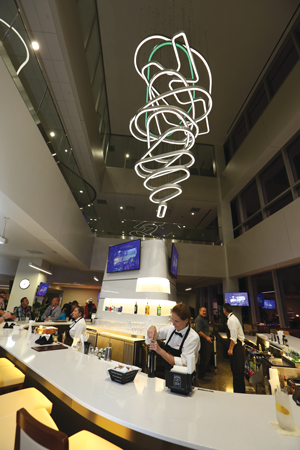 |
A chandelier in the Rolex 24 at Daytona Lounge features LED rings in the shape of ISC’s 12 tracks.
Photo by: ISC |
said. “They took the boldest approach to using the property to activate their brand. Their time and attention to detail was no less than the attention we put into the stadium itself.”
Across multiple concourses, spanning a total of 20,000 square feet, Toyota’s wall signs and interactive displays drive home a singular message that the company supplies 365,000 jobs among its 10 factories in the U.S., including many positions for military veterans through its “Hiring Our Heroes” program.
Toyota also weaves the Florida region’s NASA history into its activation on Level 3. As fans get off the escalator, they face a replica of the Space Shuttle Endeavour’s nose cone. In 2012, the Endeavour was towed by a Toyota Tundra truck to its final resting place at the California Science Center in Los Angeles. Outside the track, Toyota’s mini off-road course gives consumers the opportunity to test-drive a Tundra through mountainous conditions (see story).
“This is the biggest and most integrated activation we have [in sports], when you consider the flexibility it allows us to bring new things or things we’re doing elsewhere that we’re trying out,” Dahl said. “The fact that it has so much real estate involved and we were part of the development as opposed to going into an existing facility and just being a partner, allowed us a lot more opportunities to communicate with people. We have a whole section of the facility that’s ours, to create ‘Toyota World.’ That opportunity doesn’t really exist in a lot of other places. It’s just the way it is.”
For all founding partners, the activation starts outside the track with branded entrances tied to stairways, elevators and escalators taking patrons to the main concourse. It’s Daytona’s version of MetLife Stadium’s model of cornerstone partners at the home of the NFL’s Jets and Giants.
At the Toyota injector, for example, riding the escalator up to Level 1 takes fans past five stock cars that appear to be hurtling down an embankment, including a Joe Gibbs Racing car sponsored by tech vendor Arris, the integrator of the track’s new Wi-Fi system. At the top of the escalator, fans turn left to pass by a replica of the Kyle Busch No. 18 car (a Toyota Camry) on display and the Sprint Cup trophy Busch won after capturing the 2015 title.
Walk farther down Level 1 in the direction of Turn 4 and the Toyota Roadhouse appears, one example of the concessions space given to founding partners to brand as they see fit. The dining space features a half-dozen metal folding chairs removed from the old grandstand, a stark reminder for how badly Daytona was in need of a refresh.
For Toyota, its attention to detail comes across in the Tundra tailgates converted to booth seating at the roadhouse.
The tailgate booths are also part of Toyota’s suite on the France Level, the sixth floor and the track’s highest point.
Premium offerings
The track’s new premium seats reflect the sports industry’s overall trend for customization. The loge boxes, suites and club seats, scattered among six levels, were designed to meet the hospitality needs of corporate groups and individual ticket buyers preferring an upgraded experience.
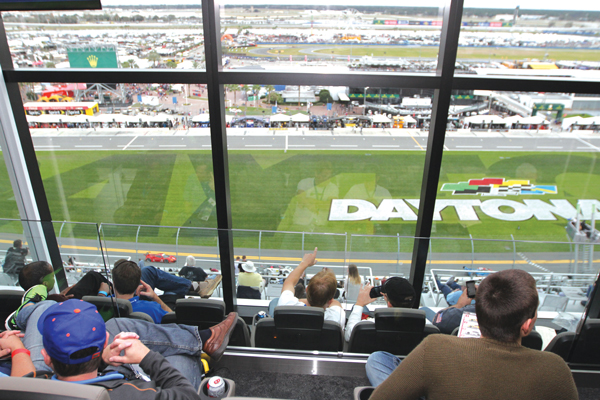 |
New premium offerings provide options for groups as small as four people.
Photos by: ISC |
Daytona’s open-air loge boxes are among the best premium seats in motorsports, situated along the start-finish line on the first level and as part of the Trioval Club on the fourth level. The cushy leather swivel chairs come with granite countertops, plug-ins for mobile devices and space to store coolers. For both Speedweeks and the Coke Zero 400 events in July, the six loge boxes on Level 1 cost $21,600. The 16 loges on Level 4 are priced at $16,000 to $24,000, depending on the number of seats purchased and location. Each box has 12 seats and individual buyers can purchase four, six, eight or 12 seats. Every loge box ticket comes with $300 in stored value to buy food and drink for Speedweeks and the track’s NASCAR event in July.
The loges were added midway through the project to provide premium options for smaller groups of people. As of early February, every loge box was sold with the exception of one 12-seat unit on the fourth level, Chitwood said.
“For us, the goal was to have all the different choices available, from four persons to 100 persons,” he said.
Harley J’s, the 500-person all-inclusive club on Level 2, was another adjustment in the design process. It originally was supposed to be part of the inventory of the Midway suites, a group product, with no views to the track. Instead, project officials came up with Harley J’s, an upgrade for those buying regular tickets in the grandstand. For Speedweeks 2016, a five-day pass costs $2,300 a person, which covers the cost of food and drink, including alcohol.
The space, which includes an outdoor patio, is named for Harley J. Earl, the late General Motors designer, close friend of NASCAR founder Bill France Sr. and creator of the Firebird X-21 that sits atop the Daytona 500 trophy.
The club’s theming extends to two bars whose edges are sculpted to resemble the Firebird’s winged fenders. Incite Design’s Alex Porbe, a Detroit artist specializing in metal fabrication and who’s done work at Ford Field and The Palace of Auburn Hills, came up with the inspiration. Chitwood especially loves the strong connection the bars make to Daytona’s brand.
“Not too many people understand the story behind the trophy, so we wanted to kind of play off Harley J.’s relationship with the speedway,” he said. “That’s when we really hit the brand out of the park.”
The Rolex 24 at Daytona Lounge inside the suite tower along the frontstretch is a key piece of the premium experience. The 31 suite holders along three levels have access to the 5,000-square-foot hospitality space run by Americrown, ISC’s in-house concessionaire. Named for the rights holder to the annual January event, the iconic Rolex wall clocks dispersed throughout the space lend a touch of elegance to the lounge. The main bar is shaped like the track in a tri-oval design. Its centerpiece is a chandelier with individual LED rings shaped for ISC’s 12 properties starting up top with the biggest (Talladega) to the smallest (Martinsville) at the bottom. The sculpture’s only green ring represents Daytona, tied to the Rolex brand and the green flag.
“The idea behind the design was to capture all of the ISC tracks in a more sculptural way,” said Matt Taylor, an
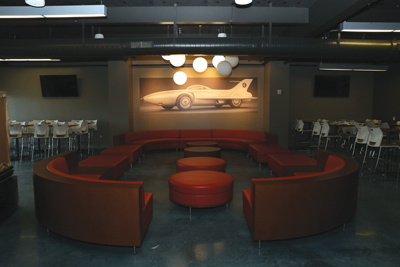 |
Harley J’s is a 500-person, all-inclusive club.
Photo by: ISC |
associate architect with Rossetti who worked on the project. “It ties into the whole bar experience, a major focal point.”
Suite prices for multiyear deals start at $26,640 for the Midway suites for the Daytona 500 only. The top price is $256,133 for the Sky Level units on the suite tower’s fifth level, a cost covering Speedweeks in February and the Coke Zero 400 in July.
For the suites as a whole, the new layout provides those premium patrons with three race-viewing options. Patrons can stay inside their private space or sit outdoors on patio space and fixed seats fronting the suites. Hanging out in the Rolex 24 lounge and its outdoor terrace is another option. Previously, most Daytona suite holders were restricted to sitting indoors and looking through glass windows to watch the race.
“This lounge level is a real departure for them and it’s resonating,” Taylor said. “People want their indoor space and patio but they also want outdoor seating. It’s a new social experience for them. They have the best of all those worlds.”
For NASCAR as a whole, it’s a brand-new world at Daytona and one ISC has managed to conquer through its motorsports stadium theme.
“It was a big commitment for us and a lot of these big projects are very challenging, but we were able to do it,” Chitwood said. “We only had one bite at that apple. That’s your biggest fear — is it going to live up to what you thought? So far, we’ve been real happy.”





